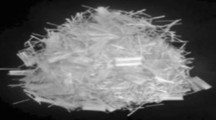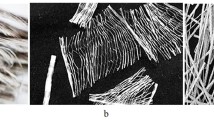Abstract
In this paper, comparative experimental study on the performance of steel fiber and PET fiber reinforced concrete has been performed. Experimental tests were carried out to highlight the effect of PET fiber parameters, mainly fiber dimensions, on the mechanical properties and fiber pull-out behavior of concrete. Results indicate that compared with steel fiber the performance of PET fiber is not good to enhance the mentioned properties, especially for compressive strength and modulus of rupture. Results showed that, in contrast to steel fiber, the performance of concrete with short and thick PET fiber is better. The existence of PET fiber in concrete has an influence on the crack bridging and changing the mode of failure of concrete to be less brittle. On the failed concrete surface, pull-out of PET fiber was not observed for concrete subjected to tension and flexure, and specimens were failed after large elongation of the plastic fiber. Analysis of global data was made to develop equations for calculating compressive strength, splitting tensile strength and modulus of rupture. Results of regression analysis indicate that these properties of concrete are dependent on the fiber index (Vf lf/df). Useful limits of fiber index were determined for each property helpful for the accurate using of PET fiber in concrete and avoiding high strength losses.




















Similar content being viewed by others
References
Adnan HM, Dawood AO (2020) Strength behavior of reinforced concrete beam using recycle of PET wastes as synthetic fibers. Case Stud Constr Mater 13:e00367
Akcaozog˘lu S, Atis CD, Akcaozog˘lu K (2010) An investigation on the use of shredded waste PET bottles as aggregate in lightweight concrete. Waste Manag 30:285–290
Albano C, Camacho N, Hernandez M, Matheus A, Gutierrez A (2009) Influence of content and particle size of waste pet bottles on concrete behavior at different w/c ratios. Waste Manag 29:2707–2716
Alfahdawi I, Osman SA, Hamid R, Al-Hadithi A (2016) Utilizing waste plastic polypropylene and polyethylene terephthalate as alternative aggregates to produce lightweight concrete: a review. J Eng Technol 11(8):1165–1173
Al-Tulaian BS, Al-Shannag MJ, Al-Hozaimy AR (2016) Recycled plastic waste fibers for reinforcing Portland cement mortar. Constr Build Mater 127:102–110
Ashby M, Shercliff H, Cebon D (2007) Materials: engineering science processing and design. Elsevier, Amsterdam
ASTM C39 (2013) Standard test method for compressive strength of cylindrical concrete specimens, annual book of ASTM standard, vol 04, October 2013
ASTM C78 (2013) Standard test method for flexural strength of concrete (using simple beam with third-point loading), annual book of ASTM standards, vol 04, October 2013
ASTM C496 (2013) Standard test method for splitting tensile strength of cylindrical concrete specimens, annual book of ASTM standards, vol 04, October 2013
Awoyera PO, Olalusi OB, Iweriebo N (2021) Physical, strength, and microscale properties of plastic fiber-reinforced concrete containing fine ceramics particles. Materialia 15:100970
Baldenebro-Lopez FJ, Castorena-Gonzalez JH, Velazquez-Dimas JI, Ledezma-Sillas JE, Gómez-Esparza CD, Martinez-Sanchez R, Herrera-Ramirez JM (2014) Influence of continuous plastic fibers reinforcement arrangement in concrete strengthened. IOSR J Eng IOSRJEN 4(04):15–23
Boiny H, Alshkane Y, Rafiq S (2016) Mechanical properties of cement mortar by using terephthalate polyethylene fibers. In: 5th National and 1st international conference on modern materials and structure in civil engineering. Tehran-Iran
Borg RP, Baldacchino O, Ferrara L (2016) Early age performance and mechanical characteristics of recycled PET fibre reinforced concrete. Constr Build Mater 108:29–47
BS 882 (2002) Specification for aggregates from natural sources for concrete. BSI, London
de Oliveira LAP, Castro-Gomes JP (2011) Physical and mechanical behaviour of recycled PET fibre reinforced mortar. Constr Build Mater 25:1712–1717
Fraternali F, Ciancia V, Chechile R, Rizzano G, Feo L, Incarnato L (2011) Experimental study of the thermo-mechanical properties of recycled PET fiber-reinforced concrete. Compos Struct 93:2368–2374
Fraternali F, Farina I, Polzone C, Pagliuca E, Feo L (2013) On the use of R-PET strips for the reinforcement of cement mortars. Compos Part B 46:207–210
Gu L, Ozbakkaloglu T (2016) Use of recycled plastics in concrete: a critical review. Waste Manag 51:19–42
Khatab HR, Mohammed SJ, Hameed LA (2019) Mechanical properties of concrete contain waste fibers of plastic straps. In: IOP conference series: materials science and engineering, vol 557. IOP Publishing, 012059. 1
Kim SB, Yi NH, Kim HY, Kim JHJ, Song Y-C (2010) Material and structural performance evaluation of recycled PET fiber reinforced concrete. Cem Concr Compos 32:232–240
Marthong S, Marthong C (2016) An experimental study on the effect of PET fibers on the behavior of exterior RC beam-column connection subjected to reversed cyclic loading. Structures 5:175–185
Meza A, Pujadas P, Meza LM, Pardo-Bosch F, Lopez-Carreǹo RD (2021) Mechanical optimization of concrete with recycled PET fibres based on a statistical experimental study. Materials 14(2):240
Meza A, Siddique S (2019) Effect of aspect ratio and dosage on the flexural response of FRC with recycled fiber. Constr Build Mater 213:286–291
Mohammed AA (2017) Properties of concrete containing PET plastic waste from post-consumed bottles. In: Proceedings of international conference on hydraulics, pneumatics, tools, sealing elements, fine mechanics, specific electronic equipment and mechatronics. HERVEX, Baile Govora, Romania, pp 325–330
Mohammed AA, Faqe Rahim AA (2020) Experimental behavior and analysis of high strength concrete beams reinforced with PET waste fiber. Constr Build Mater 244:1–13
Nibudey RN, Nagarnaik PB, Parbat DK, Pande AM (2013a) Strength and fracture properties of post consumed waste plastic fiber reinforced concrete. Int J Civ Struct Environ Infrastruct Eng Res Dev IJCSEIERD 3(2):9–16
Nibudey RN, Nagarnaik PB, Parbat DK, Pande AM (2013b) Strengths prediction of plastic fiber reinforced concrete (M30). Int J Eng Res Appl IJERA 3(1):1818–1825
Ochi T, Okubo S, Fukui K (2007) Development of recycled PET fiber and its application as concrete-reinforcing fiber. Cem Concr Compos 29:448–455
Orasutthikul S, Unno D, Yokota H (2017) Effectiveness of recycled nylon fiber from waste fishing net with respect to fiber reinforced mortar. Constr Build Mater 146:594–602
Pelisser F, Montedo ORK, Gleize PJP, Roman HR (2012) Mechanical properties of recycled PET fibers in concrete. Mater Res 15:679–686
Pereira EL, Junior AL, Fineza AG (2017) Optimization of mechanical properties in concrete reinforced with fibers from solid urban wastes (PET bottles) for the production of ecological concrete. Constr Build Mater 149:837–848
Prahallada MC, Prakash KB (2011) Strength and workability characteristics of waste plastic fibre reinforced concrete produced from recycled aggregates. Int J Eng Res Appl 1(4):1791–1802
Rebeiz KS, Fowler DW, Paul DR (1993) Recycling plastics in polymer concrete for construction applications. ASCE J Mater Civ Eng 5(2):237–248
Sadat-Shojai M, Bakhshandeh G (2011) Recycling of PVC wastes. Polym Degrad Stab 96:404–415
Siddique R (2008) Waste materials and by-products in concrete. Springer, Berlin, pp 101–104
Silva DA, Betioli AM, Gleize PJP, Roman HR, Go´mez, L.A., Ribeiro, J.L.D. (2005) Degradation of recycled PET fibers in Portland cement-based materials. Cem Concr Res 35:1741–1746
Thomas LM, Moosvi SA (2020) Hardened properties of binary cement concrete with recycled PET bottle fiber: an experimental study. Mater Today Proc 32:632–637
Wang Y, Zureick A-H, Cho P-H, Scott D (1994) Properties of fibre reinforced concrete using recycled fibres from carpet industrial waste. J Mater Sci 29:4191–4199
Wang Y, Wu H, Li VC (2000) Concrete reinforcement with recycled fibers. J Mater Civ Eng 12:314–319
Wiliński D, Łukowski P, Rokicki G et al (2016) Application of fibres from recycled PET bottles for concrete reinforcement. J Build Chem 1:1–9
Yin S, Tuladhar R, Riella J, Chung D, Collister T, Combe M, Sivakugan N (2016) Comparative evaluation of virgin and recycled polypropylene fibre reinforced concrete. Constr Build Mater 114:134–141
Acknowledgements
Major part of tests was done at the Materials laboratory, Tishk International University- Sulaimani. Efforts delivered by the laboratory’s staff especially Mr. Zanyar are highly appreciated. This research did not receive any specific Grant from funding agencies in the public, commercial or not-for-profit sectors.
Author information
Authors and Affiliations
Corresponding author
Rights and permissions
About this article
Cite this article
Mohammed, A.A., Mohammed, I.I. Effect of Fiber Parameters on the Strength Properties of Concrete Reinforced with PET Waste Fibers. Iran J Sci Technol Trans Civ Eng 45, 1493–1509 (2021). https://doi.org/10.1007/s40996-021-00663-2
Received:
Accepted:
Published:
Issue Date:
DOI: https://doi.org/10.1007/s40996-021-00663-2




